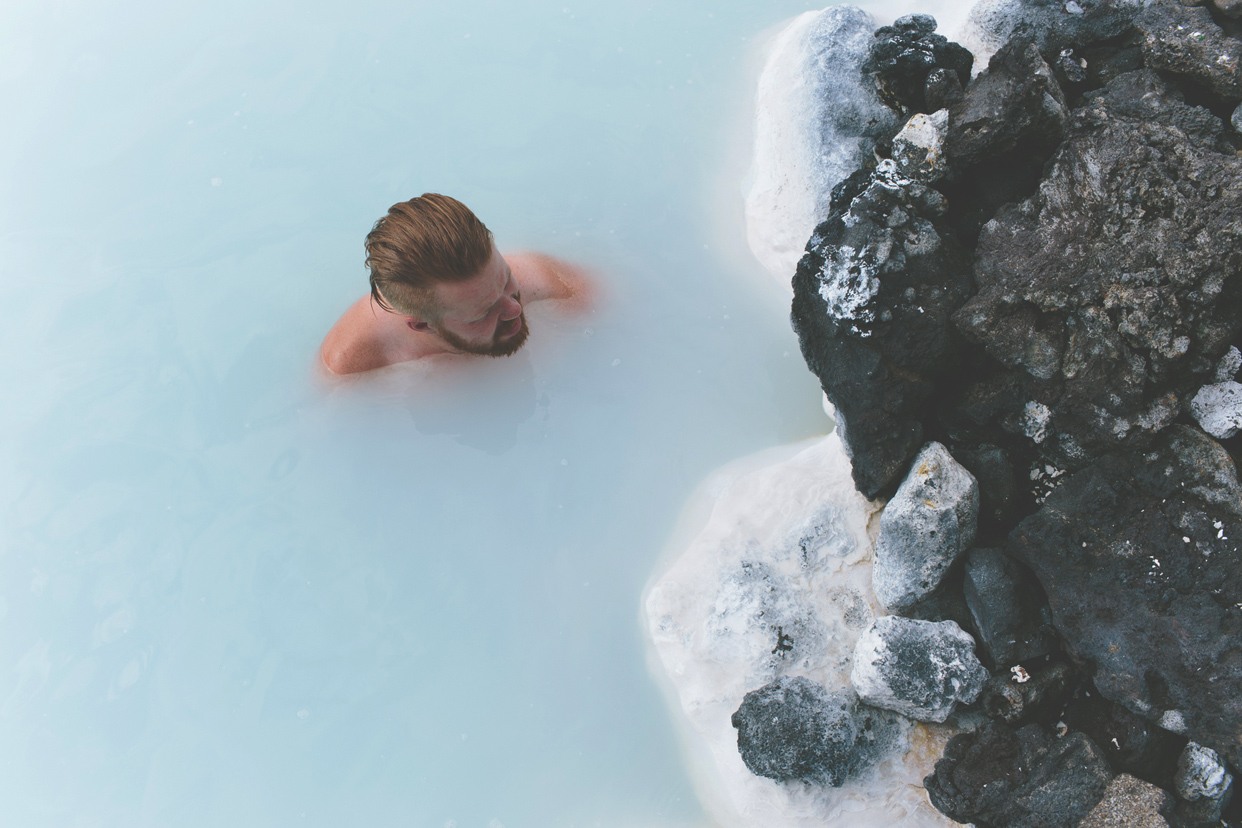Conscious Travel Guide Iceland:
What to Do and See at the Edge of the World
BY JUSTIN FAERMAN
Legend has it that Viking explorers intentionally misnamed the neighboring islands of Iceland and Greenland. Greenland, as those who have been there will know, is little more than a continent-sized mass of ice, while Iceland is somewhat of an arctic anomaly. Iceland should be frozen year
round based on the fact that it literally straddles the latitudinal line separating the arctic circle from everything South. But it just so happens that Iceland sits precariously atop a network of highly active volcanos, which mellows out its would-be harsh climate, and over geological timescales unimaginable to the human mind, has created a surreal, other-worldly landscape that permeates every square inch of the island. Some say it was savvy Viking marketing trying to attract people to a new settlement in Greenland. Others claim that Icelandic settlers knew a good thing when they saw it and were trying to keep it all to themselves.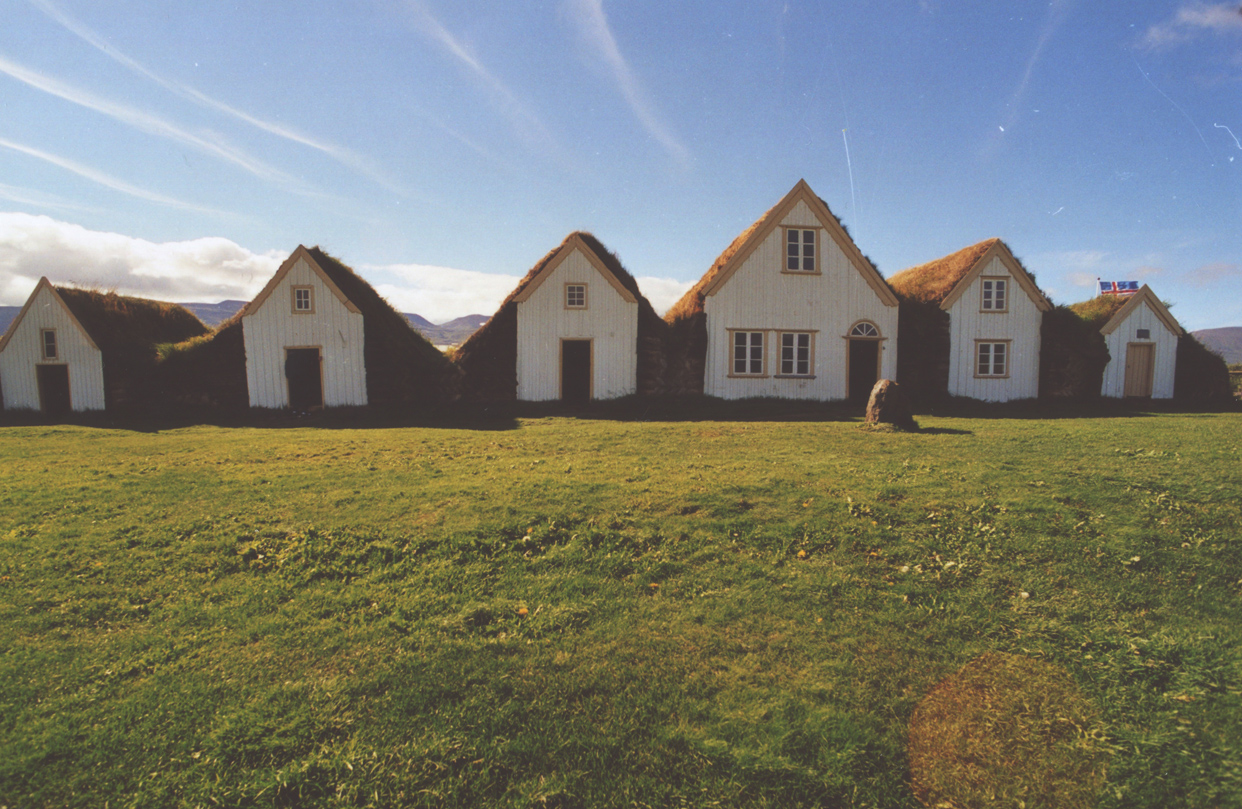 grass covered houses somewhere in the icelandic countryside. photo: tiberio frascari
grass covered houses somewhere in the icelandic countryside. photo: tiberio frascari
The truth is, Iceland is a land of paradox—a country filled with stark contrast that somehow thrives in some of the most extreme environments this planet has to offer. Iceland is so far North that if you go in winter, you’ll hardly see the sun, and if you arrive in summer, you can’t escape it (for travel purposes, know that any season is ideal and full of mind-blowing adventures and natural wonders). Right alongside massive chunks of glacial ice there’s some of the world’s most extensive, mineral-rich geothermal hot springs (which are absolutely not to be missed). If you travel out to the middle of the largely deserted island, you’ll find geysirs (an Icelandic word) shooting frothy, boiling hot water hundreds of feet into the air in the midst of snow fields that seem to stretch as far as the eye can see. Trees are scarce on the island, but that doesn’t mean it’s not green. During the spring and summer months, the Southern parts of Iceland are so lusciously green that you might think you were in Ireland, if it weren’t for the erratic volcanic mountain range or two juxtaposing the rolling fields of grass.
In the winter, traveling in Iceland can get cold, but you’ll find harsher weather in Chicago and Boston. In fact, you can be outside in just your swimming trunks in the middle of February in the right places… like the Blue Lagoon, a rich geothermal bed of volcanic hot springs, which are so phenomenally unique and beautiful that they should really be added to the list of the world’s great natural wonders (and are a must-experience travel destination if you are in the country at any time of the year).
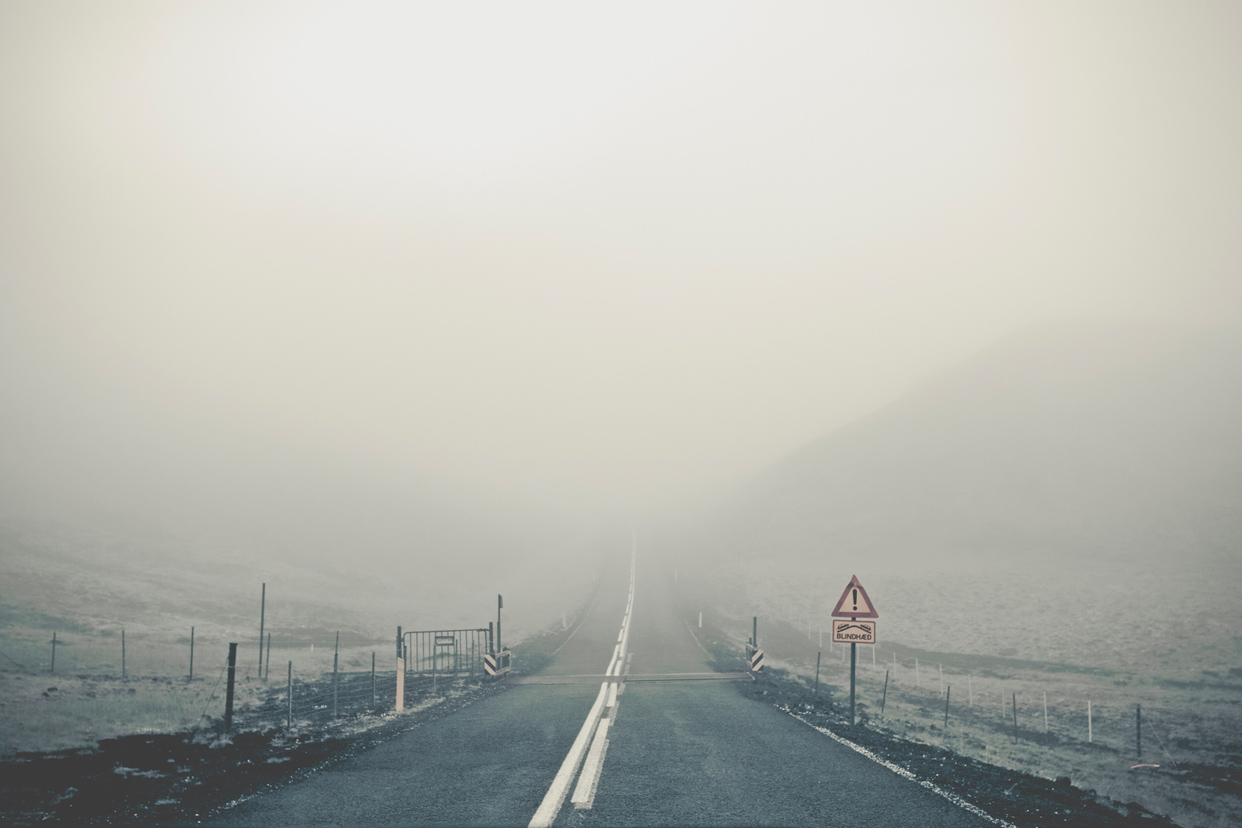 so mystical. middle of nowhere, iceland.
so mystical. middle of nowhere, iceland.
If you live in a place like Iceland, you don’t really let the weather stop you from doing anything, and no matter what season you’re there, you can find rugged tours of nearly every part of the island, allowing you to experience its varied moods and psychedelic color palettes. Depending on when you go, you might find heaving glaciers and frozen solid waterfalls or a martian-esque, blackened-lava landscape dotted with neon green patches of moss.
“If you live in a place like Iceland, you don’t really let the weather stop you from doing anything, and no matter what season you’re there, you can find rugged tours of nearly every part of the island.”
Culturally, Iceland is one of the most progressive nations on the planet, with a liberal society that makes American democrats look puritanical in comparison. That’s not to say the island is a hedonist’s paradise—quite the opposite really. Icelanders are some of the most intelligent, authentic and practical people you’ll ever meet, just as curious about why you came to visit as you are about being there. While the language is impenetrable, you’ll have a blast trying to pronounce the fifteen-letter words (filled with lovely Norse characters that look more like hieroglyphs than actual letters) that so effortlessly roll off the tongues of natives. And if you’re adventurous you can try some of the traditional dishes like hákarl, which is fermented shark meat that has been buried underground in a shallow pit for two to three months. It’s awful to be sure, but when in Rome…
Ideally, one would travel to and live in Iceland for a full year to really get to know the culture and explore the the incredible breadth of mind-bending natural wonders the tiny country has to offer. But if you’re only able to travel there for a few days or weeks, you definitely don’t want to miss out on any of the uniquely Icelandic experiences that follow.
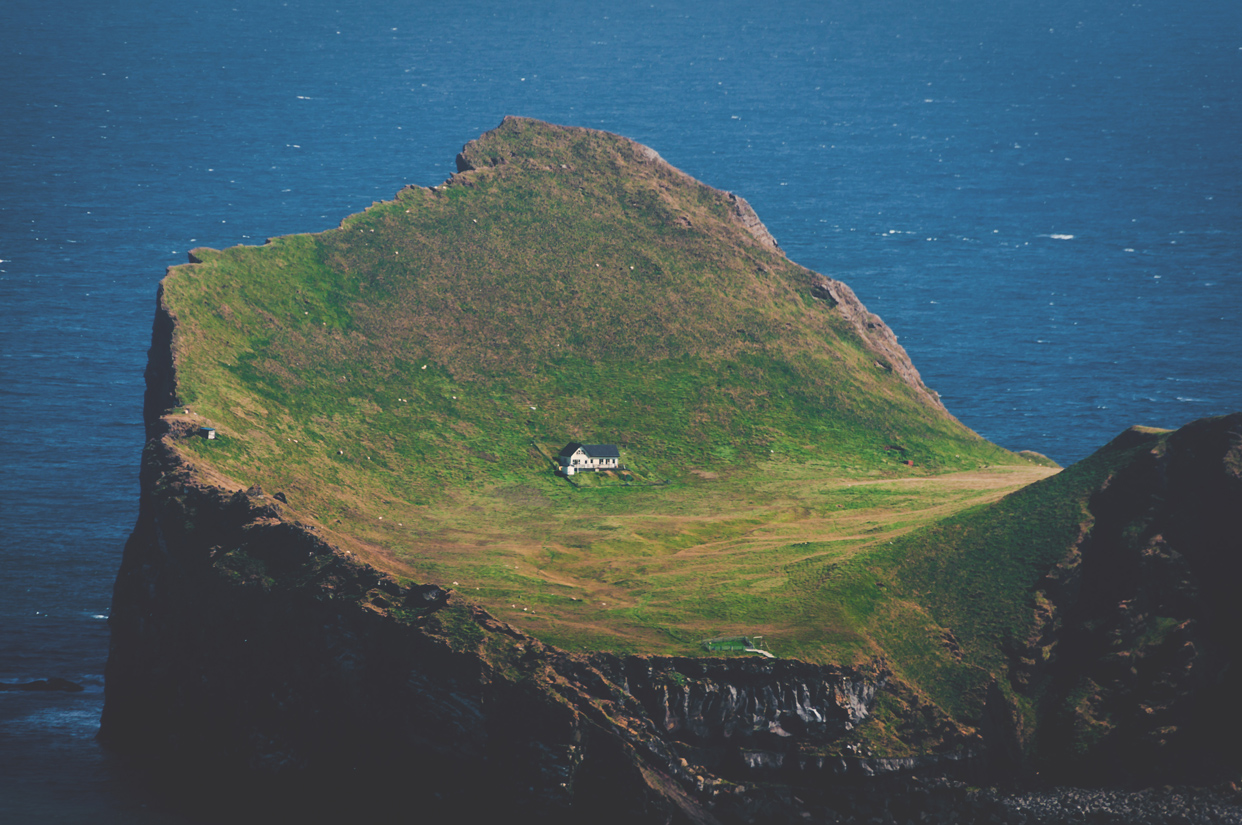 don’t just travel to iceland, ok. go the extra mile and make trek to the vestmannaeyjar islands. we promise you won’t be disappointed. photo: zanthia photocase.com
don’t just travel to iceland, ok. go the extra mile and make trek to the vestmannaeyjar islands. we promise you won’t be disappointed. photo: zanthia photocase.com
Vestmannaeyjar Islands, Iceland
Part of the lure of Iceland is its isolation from the rest of world. And if you want to get isolated in Iceland, you travel to the Vestmannaeyjar Islands. Aside from a small town on the main island in the archipelago, you’re pretty much as close to the middle of nowhere as most people care to get. And that’s a big part of the beauty of the experience. We spend so much of our lives in cities and suburbs that the simple act of placing yourself amidst the raw, untamed natural beauty of a place like the Vestmannaeyjar Islands is incredibly refreshing.
Here, nature rules the show and it’s evidenced by the almost total lack of man made structures outside the main town. The islands jut up precariously from the ocean floor, as if they are fighting for their very existence against the relentless swells of the notoriously wild North Atlantic. The craggy black lava cliffs are dotted with thousands of exotic seabirds whose incessant, synchronized movement gives the illusion that the islands are gently being swayed to and fro with the waves. If you manage to travel this far out of Reykjavik (which is a feat in itself), go the extra mile and take a boat tour—the experience of being dwarfed by the massive cliffs is worth the trip alone.
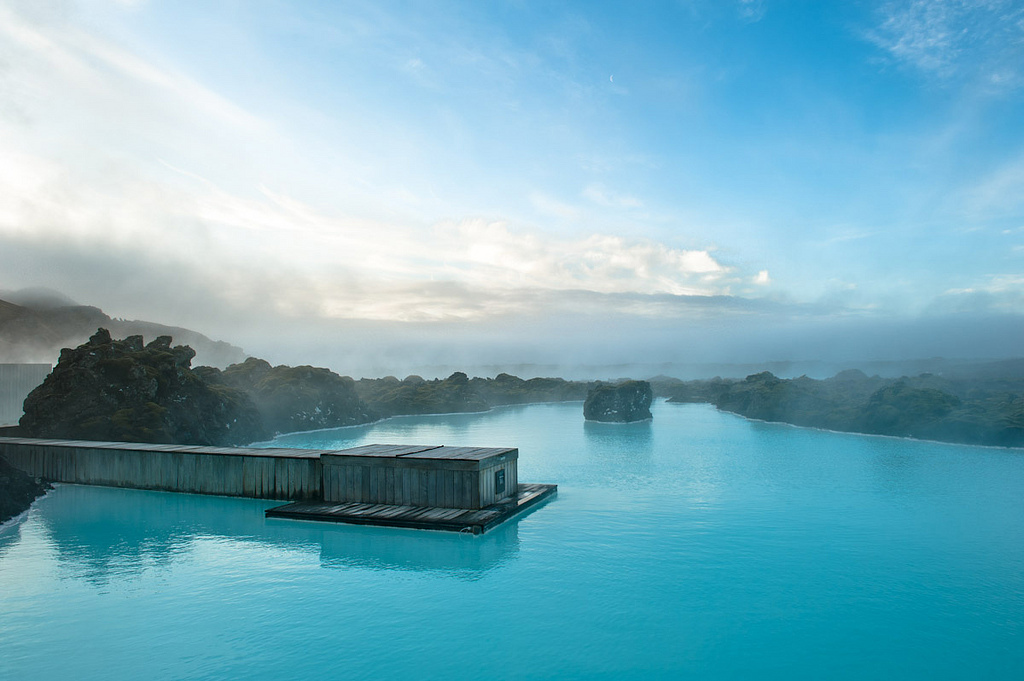 we don’t need to say anything. just go. blue lagoon, iceland. photo: pei ketron
we don’t need to say anything. just go. blue lagoon, iceland. photo: pei ketron
Blue Lagoon, Iceland
Anyone who sees a picture of the Blue Lagoon is instantly put under a hypnotic spell that’s impossible to break. One glance at the surreal, atmospheric blue water and it will find a permanent spot on your list of places to go before you die. I’ll happily admit that this was one of the main things that called me to travel to Iceland (in the middle of January no less), and I promise you it did not disappoint. If you’re into geothermal hot springs, then this is your Mecca.
What the pictures fail to reveal is the massive, pearl white silica deposit hiding just below the surface. This is the softest, most sensual patch of Earth you’ll ever set foot on. It’s so exquisite that as soon as you feel it, you’ll be compelled to rub it all over your body. And your skin will love you for it because the velvety silica-lava mud that is found in near endless supply at the springs is one of the most mineral-rich substances on the planet. There are buckets full of it strewn about the hardened black lava shoreline, and it’s nothing less than a rite of passage during your visit to smear it recklessly all over your face.Even with a modern spa complex lining the edge of the springs, this place is still pretty wild. It’s in the middle of nowhere (even by Icelandic standards—about a 45-minute drive outside Reykjavik), isolated amidst a surreal lunar landscape that’s at once stunningly beautiful and hauntingly desolate. At the springs themselves, there are patches where the water temperature gets hot enough that you can really only handle it for a few seconds before the raw exhale of heat emanating from deep within the Earth’s crust becomes almost unbearable. If you’re feeling adventurous and don’t mind getting a little cut up, there are some pretty rocky, lava-encrusted inlets you can explore in certain areas. All in all, this is an essential Iceland experience and is not to be missed.
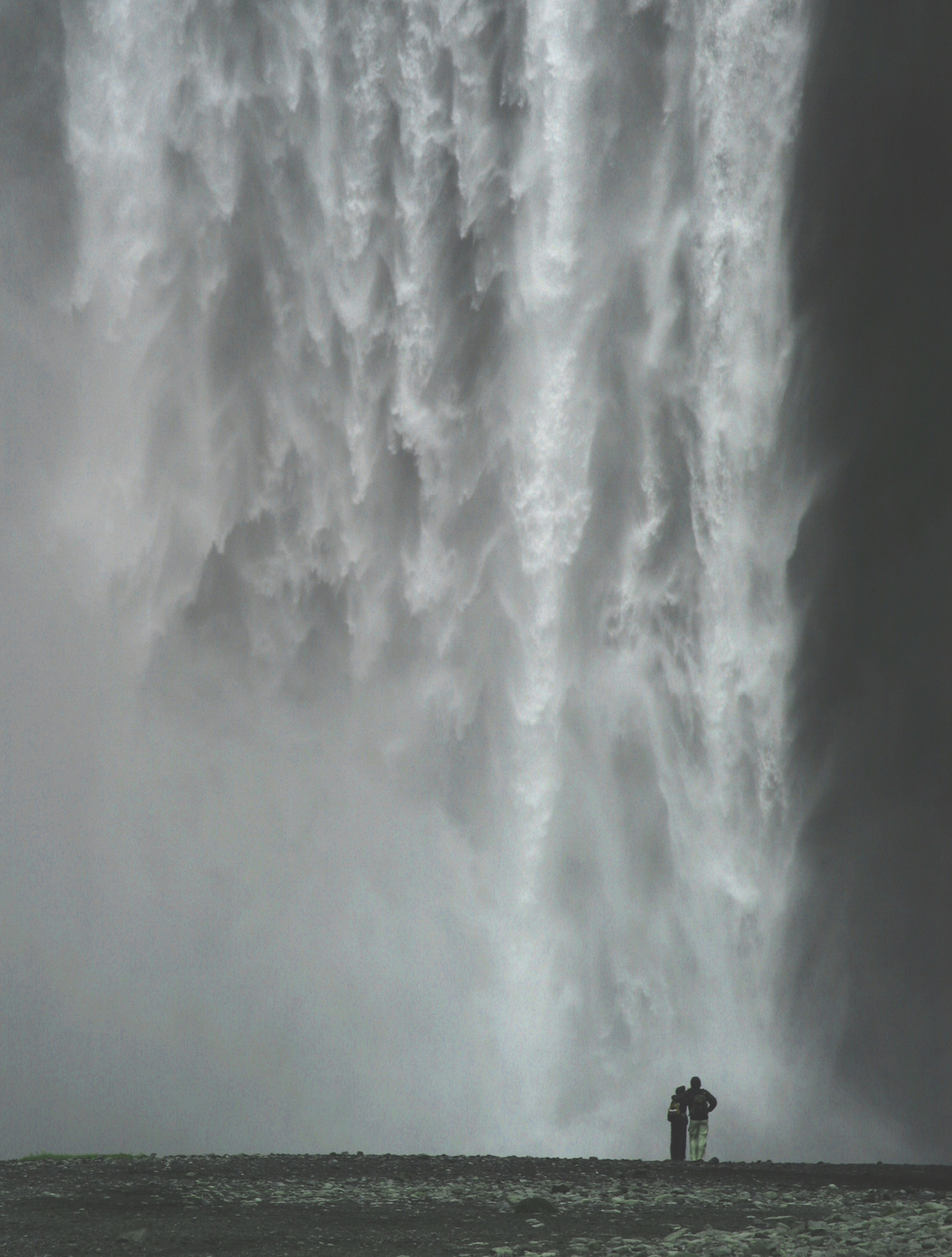 wherever you travel in iceland, great things await. photo: betrachtenswert photocase.com
wherever you travel in iceland, great things await. photo: betrachtenswert photocase.com
Seljalandsfoss & Skogafoss Waterfalls, Iceland
A few hours drive South of Reykjavik, in what could appropriately be called the Icelandic countryside, there exists a network of waterfalls that are consistently some of the biggest draws in the country. Although they are not the tallest (they are both certainly impressive when you are there), whatever they lack in mass, they more than make up for in mystical beauty. Travelers to the Seljalandsfoss waterfall can actually hike up and around the backside of it, which offers a unique perspective that makes it well worth the trip. The Skogafoss waterfall is equally stunning, often producing double rainbows on sunny days due to the copious amounts of spray and mist it generates.
The countryside surrounding and leading up to the waterfalls is intensely desolate and the view as seen through the lens of the Seljalandsfoss falls is indescribably beautiful. Standing behind the towering columns of water under the cave-like overhang, the raw power of the churning falls surging over you and hitting the ground below fills your whole body with the intensity of nature; if you close your eyes and just listen, it truly feels like you are standing in the belly of the country.
Depending on when you go, there may be pastel swatches of fragile spring flowers blooming all around the countryside or rugged fields of snow and ice, with parts or all of the waterfalls frozen solid, forming menacing-looking stalactites hanging precariously from the cliff above.
At just 23 km apart from each other, if you find yourself in the southern part of the country, it’s definitely worth stopping by.
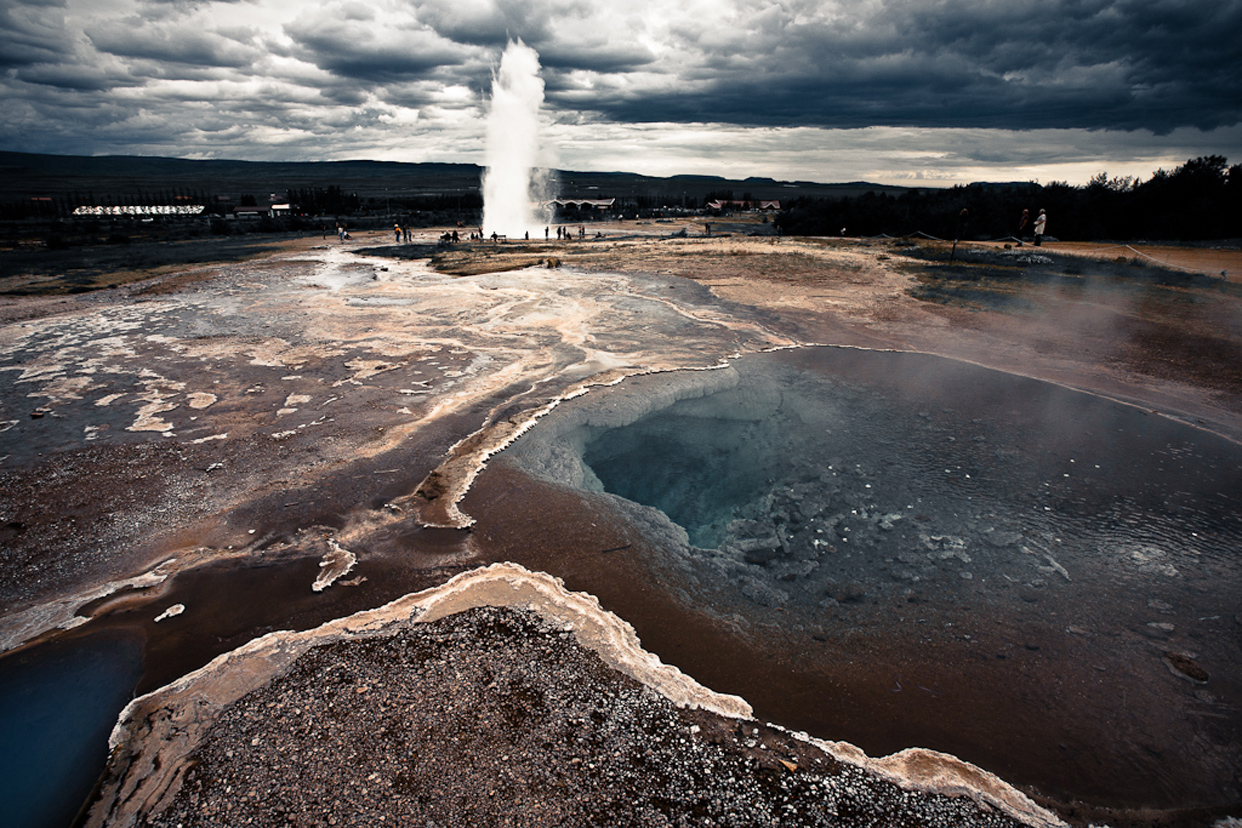 get as close as you dare to the geysirs in the heart of iceland. photo: fred mancosu
get as close as you dare to the geysirs in the heart of iceland. photo: fred mancosu
Hveravellir & Geysir, Iceland
There are two main reasons you should travel to the geysers in Iceland—for the sheer spectacle of boiling hot geothermal water spontaneously shooting skyward with ground-shaking force and the breathtaking journey of getting yourself, once again, deep into the middle of nowhere. The landscapes you traverse (literally, we forged our own road when we went) on your journey are worth the trip alone. You can make a great day out of it stopping by Thingvellir National Park, where you can see the Atlantic and Eurasian continental plates colliding in spectacular fashion and the often-frozen Gullfoss waterfall that just so happens to be on the way. And if you’re off to explore even more remote parts of the island, you should also stop by Hveravellir, a geothermal-rich area of natural hot springs nestled at the foot of a mellow mountain range in the middle of the island, dotted with mini geysers, bathing pools and surreal rock formations.
You can tell you’re getting close to Geysir when you can see the bellowing white steam rising ominously from the horizon. While it’s not the world’s biggest or most spectacular, you can get alarmingly close to it and experience its raw power and intensity from just a few feet away. You’ll need to choose your position wisely to avoid having the wind blow hundreds of gallons of steaming hot spring water all over you, which would make the lengthy car ride back to Reykjavik very uncomfortable, to say the least.There are smaller, less violent, but no less exotically beautiful geysers at Hveravellir (which translates to ‘hot spring plains’). By all accounts, this is hot spring heaven and best visited during the warmer months.
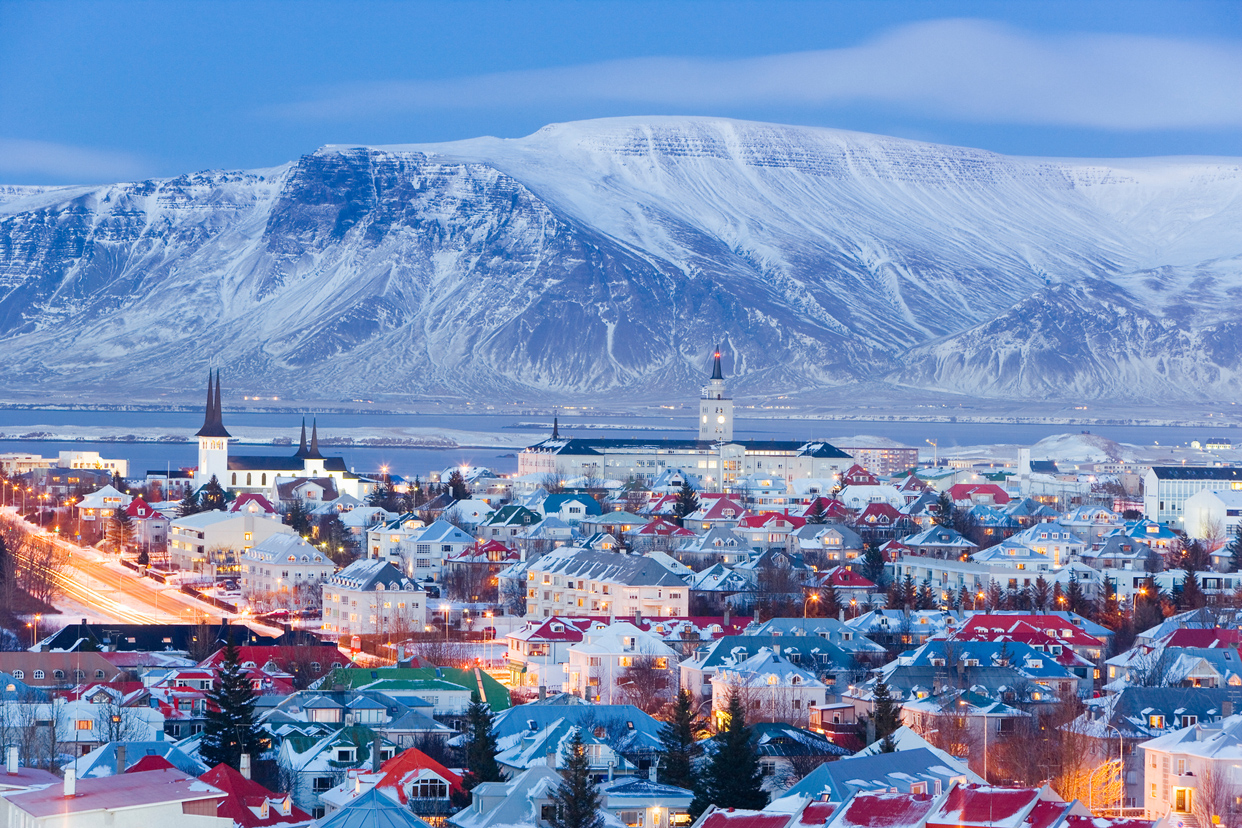 it always feels like christmas in reykjavik, iceland.
it always feels like christmas in reykjavik, iceland.
Reykjavik, Iceland
Reykjavik is the only thing in Iceland that’s not in the middle of nowhere, that is, if you ignore the fact that the entire country sits right in the heart of one of the most uninhabited, desolate areas on the planet… I suppose that makes it a sort of semi-arctic oasis. And it truly is incredible how cozy you feel in the impeccably designed Scandinavian architecture that exists in Iceland and in particular Reykjavik. After all, in order to live in such a generally harsh and unforgiving climate, you need to have a true refuge to call home.
While Reykjavik is no Rome, you’ll find it to be delightfully charming and quiet on the whole—although the city has earned itself more of a jet-setting, travel-party-hub reputation in the last decade or so. It’s no surprise as Iceland has a rich cultural heritage with some of the world’s most celebrated musicians, such as Sigur Ros and Bjork, hailing from the tiny island nation. And if you have had the pleasure of reading translations of the old Norse Sagas, you’ll know the Icelanders are master storytellers and adventurers, and the country as a whole reflects that spirit.
In Reykjavik, its worth stopping by the beckoning, post-modern Hallgrimskirkja Church that is unmistakably visible from nearly every point in the city. There’s an elevator to the top, and the view of the city and surrounding countryside is stunning.
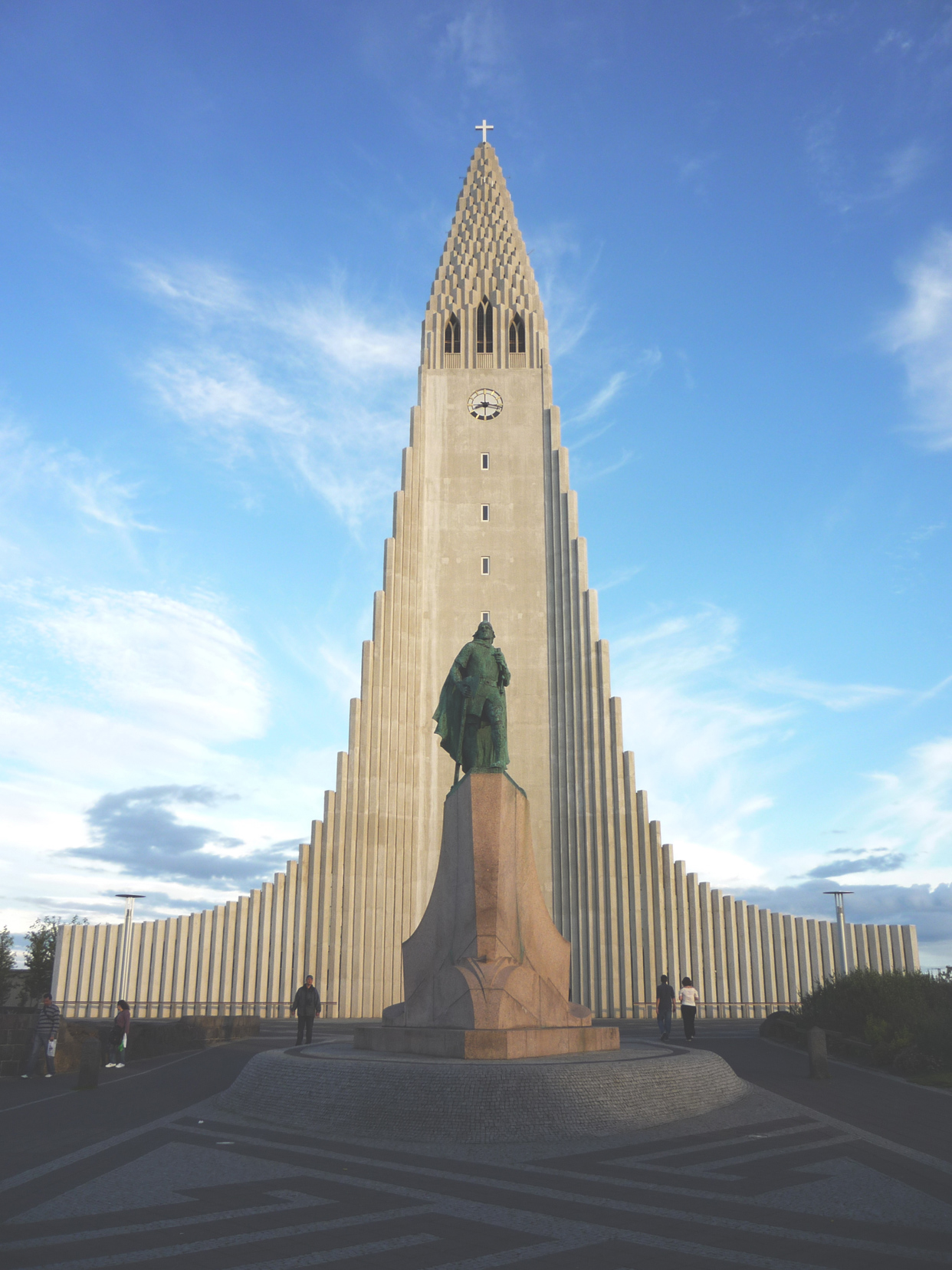 the elevator ride to the top of the hallgrimskirkja church is killer. reykjavik, iceland. photo: andrés nieto porras
the elevator ride to the top of the hallgrimskirkja church is killer. reykjavik, iceland. photo: andrés nieto porras
Like any European city, the culture is rapidly evolving and shifting. With how small the city is, if you want to know what’s best to see or do, just ask any of the friendly locals and they’ll be happy to tell you about some secret nook and cranny worth visiting and not yet in the guidebooks.
While it’s anything but the height of tourist season, I traveled to Iceland during the Christmas and New Year’s celebration known as Twelfth Night (or Þrettándinn among Icelanders), which lasts thirteen days and is truly a unique experience on this planet. Despite there only being about three hours of dreary sunlight per day, the whole country was in full party mode, and it was an incredible time to visit. Even at this time of year, the Aurora Borealis (also known as the Northern Lights) is visible and truly one of the world’s great spectacles.
But even when it was too cloudy to see the lights in the sky, there was a man made aurora going on at all times in the city. The Icelanders are very fond of very powerful fireworks, which can be found at strategic points throughout the city at this time of year. While some might find it a bit crass, the sheer playfulness and spectacle of it all, fueled by the joy and notorious Viking mischief that clearly still runs strong in the blood of many Icelanders, was an unforgettable experience and one I remember with fondness. I can guarantee you that no matter when you choose to go, you’ll almost certainly have the same experience.
About The Authors
Justin Faerman is the co-founder of Conscious Lifestyle Magazine.


